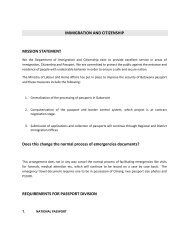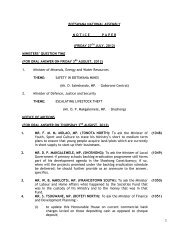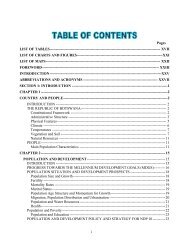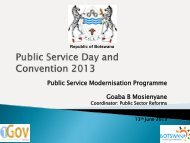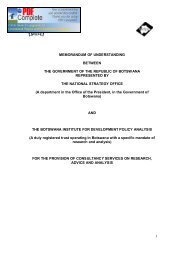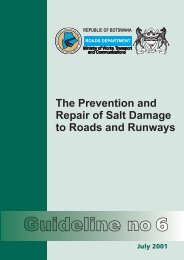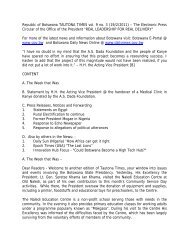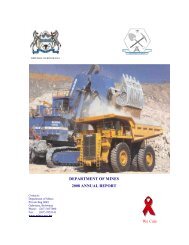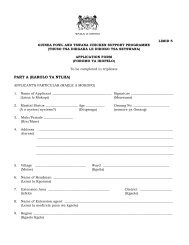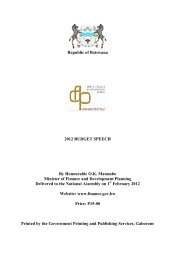National Nutrition and HIV/AIDS Guidelines for Service Providers of ...
National Nutrition and HIV/AIDS Guidelines for Service Providers of ...
National Nutrition and HIV/AIDS Guidelines for Service Providers of ...
Create successful ePaper yourself
Turn your PDF publications into a flip-book with our unique Google optimized e-Paper software.
social <strong>and</strong> health effects. Some <strong>of</strong> the undesirable health effects <strong>of</strong> alcohol include increased risk <strong>of</strong><br />
liver cirrhosis, fetal alcohol syndrome, alcohol related dementia (side effect <strong>of</strong> thiamin), impaired<br />
coordination <strong>and</strong> delayed reaction time. Alcohol also interacts negatively with some medications<br />
including ARVs. The undesirable social effects <strong>of</strong> excessive alcohol intake include involvement in crime,<br />
violence <strong>and</strong> risky sexual behavior, automobile accidents, just to mention a few.<br />
Most people who drink should be encouraged to:<br />
<br />
<br />
<br />
<br />
<br />
<br />
Eat be<strong>for</strong>e taking alcoholic beverages so they will not miss out on essential nutrients.<br />
Try non or low alcoholic drinks sometimes.<br />
Extend alcoholic drinks with low calorie mixers or water.<br />
Drink slowly take smaller sips.<br />
Reduce eating crisps <strong>and</strong> nuts when drinking alcohol as this will add more calories <strong>and</strong> fat to<br />
your intake.<br />
Reduce the intake <strong>of</strong> salty foods while drinking as doing so will cause them to thirst, <strong>and</strong> thus<br />
lead to more drinking.<br />
2.4.6 Physical activity<br />
Besides healthy eating, physical activity is <strong>of</strong> paramount importance in achieving <strong>and</strong> maintaining<br />
health <strong>and</strong> wellness. Without exercise, it is difficult to maintain good health even if one makes healthy<br />
food choices. It is recommended that adults should have a minimum <strong>of</strong> 30 minutes <strong>of</strong> physical activity<br />
3-5 times a week. This recommendation is in addition to daily household activities. For children a<br />
minimum <strong>of</strong> 60 minutes <strong>of</strong> physical activity per day, 3-5 times a week is recommended.<br />
Physical activity or manual work is strongly associated with reduced risks <strong>of</strong> chronic diseases such as<br />
Heart diseases, obesity <strong>and</strong> cancer. Physical activity also keeps the bones strong by helping the bones to<br />
be renewed (bone remodeling; thus bone re-absorption <strong>and</strong> bone <strong>for</strong>mation). The intensity <strong>of</strong> exercise<br />
is somewhat difficult to st<strong>and</strong>ardize because it is very much dependent on the physical fitness <strong>of</strong> the<br />
person exercising, his/her body weight <strong>and</strong> age, <strong>and</strong> the type <strong>of</strong> activity undertaken. Roughly<br />
moderately intense physical activity can include fast/ brisk walking <strong>for</strong> at least 30 minutes. In general,<br />
the level <strong>of</strong> physical activity can be increased by increasing body movements, such as swinging h<strong>and</strong>s<br />
while walking <strong>and</strong> by increasing the duration <strong>of</strong> the physical activity.<br />
Examples <strong>of</strong> physical activity include; walking, jogging climbing or going down stairs instead <strong>of</strong> using a<br />
lift, parking a car a bit far from your destination (e.g. shopping area) <strong>and</strong> walking to the shops, cleaning<br />
the house or yard, raking, gardening, washing clothes, gymnastics, aerobics, sporting/playing e.g.<br />
cycling, running, playing soccer, basket ball, tennis, weight-lifting exercises, etc.<br />
2.4.7 Healthy body weight<br />
Body weight is a reflection <strong>of</strong> energy balance. In order to maintain a healthy body weight it is important<br />
to strike a balance between the energy obtained from food <strong>and</strong> the energy spent through physical<br />
activity. If the food consumed provides more energy (calories) than the body uses, the excess energy<br />
will be stored in the <strong>for</strong>m <strong>of</strong> fat deposits <strong>and</strong> thereby increase the risk <strong>of</strong> non communicable diseases<br />
such as diabetes, hypertension <strong>and</strong> cardiovascular diseases.<br />
There are several anthropometric methods that can be used to estimate energy stores. The first <strong>and</strong><br />
mostly commonly used method in adults is the Body Mass Index (BMI). This method is used to evaluate<br />
the appropriateness <strong>of</strong> body weight per given stature. It is calculated as shown in the box below. BMI<br />
values between 20 <strong>and</strong> 25 are associated with the least risk <strong>of</strong> morbidity <strong>and</strong> mortality from nonn<br />
communicable diseases. As BMI increases past 25, the risk <strong>of</strong> non-communicable diseases <strong>and</strong> mortality<br />
increases. Refer to the box below to underst<strong>and</strong> the classification criteria <strong>for</strong> BMI.<br />
12



